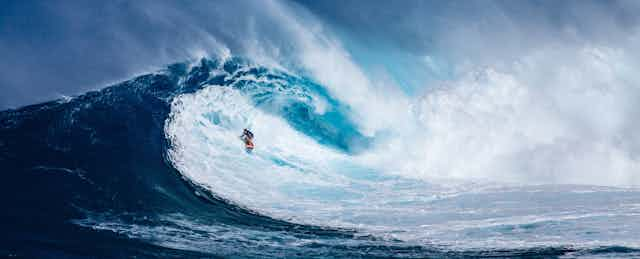BASE jumping, wingsuit flying, big wave surfing, extreme skiing and solo rope-free climbing, when we think of someone who takes part in these extreme activities, we think of a risk-taker. The type of person you might describe as a “deviant hedonist” or a “sensation-seeker”, who is looking for an “adrenaline rush”. And they are most likely to be young and male.
The problem with this stereotype of extreme sport participants, is that not only does it not always ring true, but it also means that extreme sports then become viewed in a way that makes them inaccessible to “normal people”.
This view can be extremely damaging, especially given evidence – which emerged when I was researching a book on the subject – shows that extreme sports might actually be more accessible and have more of a positive impact than traditional, competitive sports.
Interviews I conducted with people between the ages of 30 and 70 who participate in extreme sports suggested they can help to create profound and positive life changes – both in the short term and longer term. So instead of just the fast-paced experiences often portrayed in short videos of extreme sports, in reality, participants describe a feeling of peace and tranquillity during the experience that reflects something similar to mindfulness.
Over the long term, these experiences support sustained well-being benefits including the realisation that emotions, such as fear, that are traditionally considered negative, do not have to constrain one’s potential.

These reflections can often change people’s everyday lives – they described no longer “being bored with life” and talked of having a “passion” for their sport. They also reported seeing other people and the planet in a much more positive way after taking up extreme sports.
Human potential
Participants from all sorts of extreme sports often describe extraordinary sensory experiences of the sort not usually available in everyday life. This is because during participation in an extreme sport, a person’s ability to see, hear, and feel are all enhanced.
BASE jumpers, for example, talk about an enhanced capacity to see every nook and cranny, shade and colour of the rock even though they are travelling at 200 mph. Participants also describe an experience that feels like they are merging with the environment which invariably turns into a feeling of being profoundly part of nature.
This may be one reason why so many extreme sports athletes spend a great deal of energy and time working hard to educate and protect the natural environment – this glimpse into human potential acts as a learning opportunity for psychological health and well-being more generally.
The death risk
But of course when taking part in these types of activities a mismanaged mistake or accident can result in death. Perhaps this is why nonparticipants find it hard to understand why anyone would willingly undertake extreme sports – unless there is something “not normal” about “those types of people”.
But this death risk is a large part of why participation in extreme sports requires considerable commitment, along with a great deal of hard work. Extreme sports are not for those interested in the quick rush, thrills or hedonism. In fact, people interested in the short-term hedonistic outcomes might be better finding another outlet. Participants in extreme sport have to have an incredible understanding of the environment that they participate in and if the conditions are not right – such as the wind in the wrong direction for BASE jumping – then they will walk away.

Extreme sports participants also possess a well-tuned knowledge of their own physical and psychological capacities and limitations. This is vitally important, because extreme sports are not the place to find out if you can or can’t undertake an activity.
BASE jumpers do not start as BASE jumpers, just the same as big wave surfers slowly develop the skills. And solo rope-free climbers start with ropes on less difficult terrain. In most cases, the journey to extreme sports is often one of deliberate skill and knowledge development.
Sporting heroes
It is clear from my own research, that extreme sports have the capacity to shine a light on what it means to be human – and what human beings are capable of. But to realise this, as a society we need a cultural shift that accepts extreme sports as beneficial. Along with a change in view that recognises extreme sports participants as examples of what is possible in human performance.

But before you go out and find your latest BASE jumping club, the good news is that many of these benefits can be touched on through adventure sports more generally. This includes activities such as climbing, kayaking and mountaineering. Adventure sports do not have the downside of being constrained by tightly controlled fields as in football or cricket. And they are not focused on competition, winning and losing.
These sports are open to all and, like extreme sports, could help to encourage participation in physical activity – along with a great sense of well-being, and a deeper relationship with the natural environment. And if all of this can be achieved at the same time as having fun on the water, a rock-face or up a mountain, what’s not to like?

